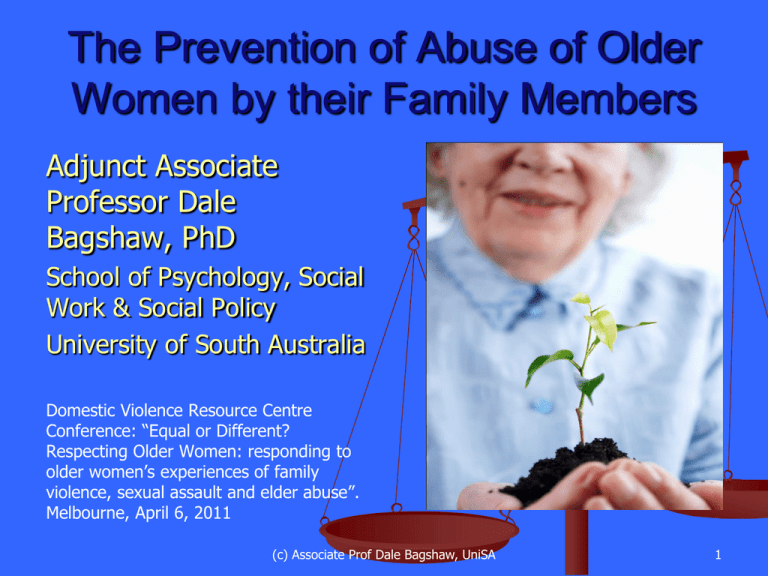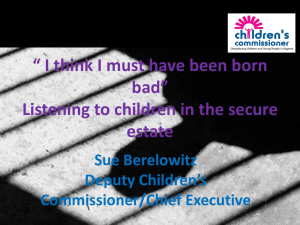
The Prevention of Abuse of Older
Women by their Family Members
Adjunct Associate
Professor Dale
Bagshaw, PhD
School of Psychology, Social
Work & Social Policy
University of South Australia
Domestic Violence Resource Centre
Conference: “Equal or Different?
Respecting Older Women: responding to
older women’s experiences of family
violence, sexual assault and elder abuse”.
Melbourne, April 6, 2011
(c) Associate Prof Dale Bagshaw, UniSA
1
UniSA Research 2007
Associate Professor Dale Bagshaw
Dr Sarah Wendt
Dr Lana Zannettino
In 2007: we conducted research for and
wrote the SA State plan
Our Actions for the Prevention of Abuse of
Older South Australians
8/04/2015
(c) Associate Prof Dale Bagshaw, UniSA
2
Relevant Publication
Bagshaw, D., Wendt, S & Zannettino, L.
Preventing the Abuse of Older People by
their Family Members. Stakeholder Paper
7, Australian Domestic and Family
Violence Clearing House, September 2009.
http://www.adfvc.unsw.edu.au
8/04/2015
(c) Associate Prof Dale Bagshaw, UniSA
3
Our current research: ARC-Linkage Grant
Associate Professor Dale Bagshaw (UniSA)
Dr Sarah Wendt (UniSA)
Dr Lana Zannettino(Flinders University)
Dr Valerie Adams (UniSA Research Associate)
in partnership with
SA Dept for Families (Office for the Ageing), Relationships
Australia SA, Office for the Public Advocate, Guardianship
Board, Alzheimer’s Australia.
Preventing the Financial Abuse of Older People by
a Family member: Designing and Evaluating Older
Person-Centred Models of Family Mediation
8/04/2015
(c) Associate Prof Dale Bagshaw, UniSA
4
The importance of language
We use the phrase
‘abuse of older people’ not
‘elder abuse’
out of respect for our
Indigenous Elders.
8/04/2015
(c) Associate Prof Dale Bagshaw, UniSA
5
What age determines when
one is ‘old’?
Varies from 45-65 depending on the
researcher, organisation or service
ABS – starts at 45 which reflects the lower
life expectancy of Indigenous adults.
Commonwealth Age pension – 65+ for
males, 60-65 for females, depending on
when they were born
8/04/2015
(c) Associate Prof Dale Bagshaw, UniSA
6
Understanding and preventing abuse of
older people by their family members is a
priority social justice issue
because of the increase in intra-familial care as a
consequence of
government ‘ageing-in-place’ policies,
the rapidly ageing population,
limited resources for extra-familial care-work,
international agreements about human rights,
in addition to the ‘complex and diverse nature of
elder abuse’
(Livermore, Bunt & Biscan, 2001: 41)
8/04/2015
(c) Associate Prof Dale Bagshaw, UniSA
7
Definitions and types of abuse
The most commonly used definition of
abuse of older people in Australia is:
Any act occurring within a
relationship where there is an
implication of trust, which results in
harm to the older person. Abuse can
include physical, sexual, financial,
psychological, social and/or neglect.
8/04/2015
(c) Associate Prof Dale Bagshaw, UniSA
8
Responses to the definition from SA service
providers in our prior research
The vast majority of respondents to
our SA survey of service providers
supported the need for a broader
understanding of abuse to include
abuse occurring in relationships
where there is an imbalance of power
and control (80%), which is central to
definitions of domestic or family
violence.
8/04/2015
(c) Associate Prof Dale Bagshaw, UniSA
9
Other additions to the definition from SA
service providers in our prior research
abuse of older people can be gendered
(86%)
abuse of an older person’s rights (86%)
cultural abuse (86%)
spiritual abuse (85%)
abuse of an older person’s pets (85%).
abuse can also involve an act or a failure
to act, as in cases of neglect (73%).
8/04/2015
(c) Associate Prof Dale Bagshaw, UniSA
10
Abuse is more than physical
It is likely that many members of the
community may not have heard the term
‘elder abuse’ and/or may only believe that
behaviour is abusive if it is physical.
The older person may be subjected to
several different kinds of abuse at the
same time to a lesser or stronger degree.
Non-physical forms of abuse may be
subtle and hard to detect.
8/04/2015
(c) Associate Prof Dale Bagshaw, UniSA
11
‘Mistreatment’ sometimes used
Mistreatment can involve an act of
commission (abuse) or omission (neglect)
which can be intentional, wilful, deliberate
or malicious, or unintentional, benign,
passive or recklessness.
8/04/2015
(c) Associate Prof Dale Bagshaw, UniSA
12
Explanations for perpetrator
behaviour
Perpetrator behaviour can be labelled as
abusive, neglectful or exploitative,
depending on its frequency, duration,
intensity, severity, consequences and the
cultural context.
8/04/2015
(c) Associate Prof Dale Bagshaw, UniSA
13
Types of abuse
physical
abuse can include being
hit, sexually assaulted, burned or
physically restrained
psychological abuse can include
humiliation, insults, fear, threats
or being treated like a child.
8/04/2015
(c) Associate Prof Dale Bagshaw, UniSA
14
Neglect
Neglect can include passive neglect,
which refers to older people being left
alone, isolated, or forgotten and
active neglect, which is the
withholding of items that are
necessary for daily living, such as
food and medicine
8/04/2015
(c) Associate Prof Dale Bagshaw, UniSA
15
Types of abuse
Medical abuse can include the
inappropriate use of constraints and
withholding or careless administration of
drugs
Social and environmental abuse can
include a failure to provide human services
and involuntary social isolation
8/04/2015
(c) Associate Prof Dale Bagshaw, UniSA
16
Financial abuse:
making improper use of an older person’s property
or money without his or her knowledge or
permission such as
forgery
stealing
forced changes to a will
transferring money or property to another
person
withholding funds from the older person and the
failure to repay loans.
8/04/2015
(c) Associate Prof Dale Bagshaw, UniSA
17
Financial abuse
It can also include the misappropriation of
enduring powers when a trusted person
(usually a family member) is legally
appointed with enduring powers to
manage the financial affairs of the older
person whose frailty is increasing and can
no longer manage their own affairs.
With the ageing population and the
increasing complexity associated with
financial management, this type of abuse
is likely to increase.
8/04/2015
(c) Associate Prof Dale Bagshaw, UniSA
18
Our findings from prior research
The abuse of older people:
is an under-researched and hidden
problem
occurs across the spectrum of our society
is often unrecognised, unreported, and
hard to detect.
There is currently no central register for the
collection of statistics when abuse is
uncovered or reported.
8/04/2015
(c) Associate Prof Dale Bagshaw, UniSA
19
Prevalence
Australian and overseas studies have
estimated that between 3 and 5% of older
people aged 65 years and over and living
at home suffer from various forms of
abuse or neglect (Kurrle 2004, p.809).
These figures vary with the methods and
definitions used.
Most of the abused older people are
women
(Rabiner, O’Keefe & Brown, 2004).
8/04/2015
(c) Associate Prof Dale Bagshaw, UniSA
20
Prevalence in Australia
Australian Institute of Criminology found
that ‘4.6% of older people are victims of
physical, sexual or financial abuse,
perpetrated by family members and those
in a duty of care relationship’ (Kinnear &
Graycar 1999, p.1).
8/04/2015
(c) Associate Prof Dale Bagshaw, UniSA
21
Cooper et al (2008) reviewed 49 studies
searched multiple databases to October
2006 and found that in the general
population, an estimated 6% of older
people reported significant abuse in the
last month and 5.6% of couples reported
physical violence in their relationship in
the last year.
Significant abuse was defined as one
abusive act occurring two to three times
per month.
8/04/2015
(c) Associate Prof Dale Bagshaw, UniSA
22
Prevalence and types of abuse
Psychological and financial abuse—
non-physical forms of abuse—are the
most likely forms of abuse to be
reported by people 65 and over
(Schofield et al 2002: 25; Chen et al
2007).
8/04/2015
(c) Associate Prof Dale Bagshaw, UniSA
23
Prevalence and types of abuse
Several researchers have found or inferred
that the most common form of reported or
suspected abuse is financial abuse
followed by psychological and physical
abuse – its not uncommon for more than
one type of abuse to occur together.
Researchers have also concluded that the
people most likely to commit financial
abuse are the older person’s adult
daughter or son
(Brill, 1999; Cripps, 2001; Boldy, Webb, Horner, Davey, & Kingley, 2002; Faye &
8/04/2015
Sellick,
2003).
(c) Associate Prof Dale Bagshaw, UniSA
24
Financial abuse - prevalence
The Office for the Public Advocate in Western
Australia found that, during 1995-1998, 10% of
applications alleged financial abuse and relatives
were most often the alleged perpetrators.
Aged Rights Advocacy Service in South Australia
found financial abuse in one third of 100 cases
over a period of 2 years, the majority of which
involved women as victims aged over 75 years
(James & Graycar, 2000; Cripps, 2001).
8/04/2015
(c) Associate Prof Dale Bagshaw, UniSA
25
Financial abuse of older Aboriginal
Australians
Financial abuse has also been found
to be the most common form of
abuse experienced by older Aboriginal
people
(Office for the Public Advocate, 2005).
8/04/2015
(c) Associate Prof Dale Bagshaw, UniSA
26
Financial abuse
The Office of Seniors Victoria (2005) has
stated that financial abuse is emerging as
a significant form of abuse, and
highlighted the need for financial literacy
training, support from the financial
services industry, education and
specialised legal services.
8/04/2015
(c) Associate Prof Dale Bagshaw, UniSA
27
Abuse by family members
The majority of abusers of older people
(80-90%) in Australia are close family
members (Kurrle 2004, p.809).
Kinstle, Hodell and Golding (2008) point
out that adult children or other family
members are most likely to provide the
assistance required by the disabled or
dependent elderly person.
8/04/2015
(c) Associate Prof Dale Bagshaw, UniSA
28
Abuse by family members
Although the vast majority of families
provide their ageing parents or relatives
with a safe haven, it is also true that
family members perpetrate the majority of
reported incidents of abuse of older
people (Johnson 1997; Cripps 2001; Boldy
et al. 2002; Cavanagh 2003).
8/04/2015
(c) Associate Prof Dale Bagshaw, UniSA
29
Gender and abuse
Studies have found that abuse of older
people within the family is still largely the
abuse of older women by older and
younger men, and that older women are
particularly at risk of financial abuse,
physical abuse, and sexual abuse
(e.g. see Penhale 1999; Boldy et al. 2002;
Faye & Selleck 2003; Nerenberg 2008).
8/04/2015
(c) Associate Prof Dale Bagshaw, UniSA
30
Gender and abuse
However, the gendered nature of the
abuse of older people is still relatively
invisible in Australia in spite of evidence
from the Australian Bureau of Statistics
(2006) that one in four women who have
experienced an incident of physical
violence is aged 45 years and older, a
finding supported by other Australian
research (e.g. Morgan Disney & Associates 2000).
8/04/2015
(c) Associate Prof Dale Bagshaw, UniSA
31
1st UK National Prevalence Study 2009:
Elder Mistreatment (abuse & neglect)
Researchers conducted a face-to-face survey with
2,111 older people 66 and older who were living at
home or in the community and found that
women (90%) were significantly more likely to
have experienced mistreatment than men during
the previous year,
there were gender differences according to the
type of abuse and perpetrator characteristics
(Biggs et al, 2009).
8/04/2015
(c) Associate Prof Dale Bagshaw, UniSA
32
UK Study: gender differences
Overall, 2.6% of the respondents reported
that they had experienced mistreatment
during the time period, the most common
being neglect (1.1%), followed by
financial abuse (0.7%).
Women were significantly more likely than
men to have experienced neglect and
physical, psychological and sexual forms
of abuse, whereas the prevalence of
financial abuse was similar for both sexes.
8/04/2015
(c) Associate Prof Dale Bagshaw, UniSA
33
UK study – age and gender effects
When age and gender effects were compared,
the prevalence of neglect was highest among
women 85 and older, however the interpersonal
abuse of older women decreased with age.
Older people who were separated or divorced
were more likely to be mistreated and people
living alone were more likely than those living
with others to have experienced financial abuse.
The prevalence of mistreatment also
increased with declining health status.
8/04/2015
(c) Associate Prof Dale Bagshaw, UniSA
34
UK study: perpetrator characteristics
51% of mistreatment in the past year was
carried out by a partner or a spouse, 49%
by another family member, 13% by a care
worker, and 5% by a close friend.
the main perpetrators of financial abuse
were other family members (54%) and
care workers (31%) and only 13% were
partners.
8/04/2015
(c) Associate Prof Dale Bagshaw, UniSA
35
UK study: perpetrator characteristics
Men were predominantly the perpetrators
of interpersonal abuse (80%), but the
gender split for financial abuse was more
equal for men and women (56% men,
44% women).
Overall 53% of perpetrators were living in
the respondent’s household at the time of
the abuse (ibid: 7-11).
8/04/2015
(c) Associate Prof Dale Bagshaw, UniSA
36
DV and older women
The domestic violence sector has tended to
focus on younger women and their
dependent children and until recently has not
paid as much attention to older women
experiencing ongoing domestic violence.
Some researchers have recognised that
abuse of older people is highly likely to be
‘spouse abuse grown old’ (e.g. Nerenberg
2008; Leisey, Kupstas & Cooper, 2009;
Brandl, 2000).
8/04/2015
(c) Associate Prof Dale Bagshaw, UniSA
37
The issue of power
The patriarchal power structures in society
infiltrate personal lives and intimate
relationships and so the issue of power is
crucial to understanding the role of age
and gender in the abuse of older people
(Whittaker 1997; Sengstock 1991).
8/04/2015
(c) Associate Prof Dale Bagshaw, UniSA
38
Older women’s experiences may be
different to those of older men
They tend to live longer than men and
are more likely to be financially abused after
their partner dies (Brozowski & Hall 2004)
They are more likely to be abused by a
broader range of family members than men
(Livermore, Bunt & Biscan 2001).
They are less likely to have access to
superannuation and, therefore, more likely to
rely on the Aged Pension (Association of
Superannuation Funds of Australia 2011).
8/04/2015
(c) Associate Prof Dale Bagshaw, UniSA
39
Abuse of older people with dementia
Strong link between abuse of older people
and dementia.
Increasing number of people diagnosed
with dementia specifically in the older age
groups who will not be able to manage
their financial affairs.
Predictions that the number of Australians
who will develop dementia in 2050 will be
approximately 2.8% of the projected
population; currently it is 1%. [1]
[1] Access Economics Pty Ltd, for Alzheimer’s’ Australia. Dementia Estimates
and Projections: Australian States and Territories. February 2005
8/04/2015
(c) Associate Prof Dale Bagshaw, UniSA
40
Factors that contribute to the abuse of
older people by family members
Family members believing that they are
entitled the older persons assets as part of
their inheritance (first in our ARC research).
Increased isolation with aging.
Lack of access to extended family or
communities of support – worse for CALD
women.
Violence from a spouse or partner(DV)
persisting into old age.
8/04/2015
(c) Associate Prof Dale Bagshaw, UniSA
41
Factors that contribute to the abuse of
older people by family members
Widening gap between generations in the
family.
Family members feeling a duty of care and
failing to access outside assistance .
Marital stress between an older couple, in
particular when sharing a home with
others.
Intergenerational violence
8/04/2015
(c) Associate Prof Dale Bagshaw, UniSA
42
Factors that contribute to the abuse of older
people by family members
Dependency on family members, in particular
financial dependency.
Language, religious and cultural barriers
restricting knowledge about, and/or access to
services.
Abuser having a drug or alcohol addiction,
gambling problem or mental illness.
Carer experiencing significant stress.
Older person suffering from dementia
contributing to a carer’s stress or to abuse of
a carer.
8/04/2015
(c) Associate Prof Dale Bagshaw, UniSA
43
Factors that contribute to the abuse of older
people by family members
Older people being placed in an
inadequately resourced institution by
family
Losing a partner or spouse.
Family members working the
land/business that belongs to the older
person
Family member who is separated or
divorced.
8/04/2015
(c) Associate Prof Dale Bagshaw, UniSA
44
Factors that contribute to the abuse of older
people by family members
Family members lacking relevant
information, knowledge, skills, resources.
Professionals not having the knowledge or
resources to identify or deal with the
abuse.
Colonisation and removal of Aboriginal
children from families.
Ageist and racist community attitudes.
8/04/2015
(c) Associate Prof Dale Bagshaw, UniSA
45
Barriers to older people reporting abuse.
diminished cognitive capacity
mental or physical disability
poor or restricted mobility
lack of awareness of what constitutes
abuse
lack of knowledge of their rights or
resources
social isolation or fear of alienation
8/04/2015
(c) Associate Prof Dale Bagshaw, UniSA
46
Barriers to older people reporting abuse
the need to preserve a family relationship
dependency on others in the family
the stigma and shame associated with abuse
literacy and language barriers
religious, generational and cultural barriers
fear of reprisal from the perpetrator and
a perceived or actual lack of options or access to
services.
8/04/2015
(c) Associate Prof Dale Bagshaw, UniSA
47
Barriers to reporting for older
Indigenous Australians
In Indigenous communities another layer
of complexity relates to the negative,
historical experiences of interventions
which led to separation and loss for many
people.
Older Indigenous people mostly want to
stay in their families and communities and
fear removal if they say anything about
the abuse.
8/04/2015
(c) Associate Prof Dale Bagshaw, UniSA
48
The DV and Ageing sectors
Dominant approaches to research,
definitions and intervention in the DV
and ageing sectors can differ
markedly and lead to inadequate and
inconsistent responses.
8/04/2015
(c) Associate Prof Dale Bagshaw, UniSA
49
The Aging and DV Sectors in
Australia
DV sector tends to focus on dynamics of
power and control and the structural (e.g.
the social, political, legal, economic and
cultural) barriers for victims
Dominant definitions of ‘elder abuse’ in
the ageing sector in Australia do not
address issues of power and control
8/04/2015
(c) Associate Prof Dale Bagshaw, UniSA
50
Complex nature of abuse
Domestic violence research has shown
that all forms of abuse are often
interconnected and are part of a complex,
shifting kaleidoscope or mosaic of abuse,
often with the misuse or abuse of power
and control at the centre (Bagshaw 2003).
8/04/2015
(c) Associate Prof Dale Bagshaw, UniSA
51
The failure to view family violence
through a gendered lens ignores the
social, political and economic context of
family violence, in particular the structural
inequality of power between men and
women in intimate relationships, and can
place many older victims who have
experienced a lifetime continuum of family
violence in a dangerous and fearful
position.
8/04/2015
(c) Associate Prof Dale Bagshaw, UniSA
52
Feminist research
Attitudes to women,
women’s status and position in society,
social and cultural constructions of gender
and gender roles, and
the privacy accorded to home and family
relationships
all act to prevent individuals, professionals
and communities from recognising,
disclosing and responding appropriately to
family violence.
8/04/2015
(c) Associate Prof Dale Bagshaw, UniSA
53
The need for a common understanding of
what constitutes abuse of an older person
Social constructions of ageing, gender and
of what constitutes ‘abuse’ are definitional
factors which influence how the
community, older people and service
providers understand and respond to what
is happening in abusive relationships.
8/04/2015
(c) Associate Prof Dale Bagshaw, UniSA
54
Explanations for the abuse
Ramsey-Klawsnick (2000) points out that
there are a variety of theoretical
explanations for abuse of older people by
their family members which give rise to
various descriptions of and responses to
the abuser.
8/04/2015
(c) Associate Prof Dale Bagshaw, UniSA
55
It is important to engage with domestic
violence theories and research to
understand the gendered nature of abuse
of older people and to avoid simplistic
medical labels and caregiver stress
explanations. Collusion by service
providers with the perpetrator is likely
and interventions can then focus on taking
care of the perpetrator and can ignore the
safety of the victim.
8/04/2015
(c) Associate Prof Dale Bagshaw, UniSA
56
Studies suggest that the long-term or preabuse nature of relationships between
caregivers and care recipients may be an
important factor in predicting abuse of
older people by family members
We need to explore potential contributions
from studies of domestic violence and
child abuse.
8/04/2015
(c) Associate Prof Dale Bagshaw, UniSA
57
Abuse of older people is a public issue
requiring a community response and in
serious cases a criminal justice response.
In the United States, growing numbers of
cases involving the abuse of older people
are given increased penalties and or
prosecuted due to new techniques,
procedures and statutory innovations and
to a wide range of professionals receiving
training in abuse detection and response.
8/04/2015
(c) Associate Prof Dale Bagshaw, UniSA
58
8/04/2015
(c) Associate Prof Dale Bagshaw, UniSA
59
Culture and race
At June 2008, 5.5 million migrants from
over 200 countries living in Australia were
born overseas (Australian Bureau of
Statistics, 2008)
The dearth of research literature on the
issue of elder abuse in CaLD communities
is largely due to the communities
emphasis on family privacy + fears that
disclosure of abuse will lead to being cut
off from their cultural communities
8/04/2015
(c) Associate Prof Dale Bagshaw, UniSA
60
Office of the Public Advocate in Western
Australia (2006)
CaLD older people are at risk of abuse
because of
poor English skills
social isolation
dependency on family members
cross-generational factors which result in
differing expectations of care and support
fear of being shamed by and excluded
from their communities
8/04/2015
(c) Associate Prof Dale Bagshaw, UniSA
61
New and emerging populations
Older people in new and emerging
population groups in Australia face
additional challenges in re-settlement such
as:
family unemployment,
poverty,
the changed roles and rights of older people
(particularly older women),
lack of family support and intervention,
social isolation, and inter-generational conflicts
(Bonar & Roberts 2006).
8/04/2015
(c) Associate Prof Dale Bagshaw, UniSA
62
Lack of knowledge of Australian law and
services, as well as communication and
language difficulties, can result in older
CaLD victims tolerating abuse
(Bagshaw, Wendt & Zannettino 2007; WA
Family & Domestic Violence Unit 2006).
8/04/2015
(c) Associate Prof Dale Bagshaw, UniSA
63
Approaches and principles for
prevention of abuse of older people
Abuse of older people is largely
undetected by service providers’ as it is
invisible and, therefore, service providers
(e.g. doctors, carers, household help,
police, clergy) need education and
resources to assist them to identify abuse,
establish or adhere to appropriate
protocols, screen for abuse, respond
effectively, and make appropriate
referrals.
8/04/2015
(c) Associate Prof Dale Bagshaw, UniSA
64
Approaches and Principles
Raising awareness of the problem is the
first step towards reducing it - public
education will help combat ageist beliefs.
Secondly, specific education for legal,
health care and social service providers is
important to reduce the risk associated
with ageism and other societal beliefs that
contribute to abuse of older people
8/04/2015
(c) Associate Prof Dale Bagshaw, UniSA
65
Approaches and principles
Thirdly, there is a need for family and
other informal forms of social support for
older people to maintain their
independence and quality of life.
Finally, participatory models hold the most
potential to address the ageist context in
which abuse occurs, allowing older people
to own responses instead of relying on
professional expertise.
8/04/2015
(c) Associate Prof Dale Bagshaw, UniSA
66
Models of prevention
Nerenberg (2008, p.35-74) explores the
strengths and limitations of seven models of
prevention which I do not have time to
address today (see our Stakeholder Paper):
Adult Protective Services,
Domestic Violence Prevention,
Public Health,
Victim Advocacy,
Restorative Justice,
Family Caregiver Support &
Family Preservation
8/04/2015
(c) Associate Prof Dale Bagshaw, UniSA
67
Mandatory reporting
In 2005, the Victorian Government Report
of their Elder Abuse Prevention Project
found that mandatory reporting and
statutory adult protection services were
not supported in its consultation process
8/04/2015
(c) Associate Prof Dale Bagshaw, UniSA
68
Mandatory reporting
In March 2006, the Elder Abuse Prevention Unit
(EAPU) decided that mandatory reporting of
elder abuse will divert resources from addressing
this issue and deny the rights of seniors to make
their own decisions, thereby reinforcing ageist
stereotypes.
The obligation for a worker to report abuse of
an individual with impaired capacity is clear
under duty of care requirements.
8/04/2015
(c) Associate Prof Dale Bagshaw, UniSA
69
Domestic Violence Prevention Model
Focuses on empowerment and micro and
macro interventions to address power
imbalances.
Raising awareness of the connections
between abuse of older people and
domestic violence is important, including
educating and training all staff working
with older people and we suggest that
more resources should be allocated for
this to happen in Australia.
8/04/2015
(c) Associate Prof Dale Bagshaw, UniSA
70
Interagency collaboration
Finally, we stress the importance of
interagency collaboration as the abuse of
older people is a ‘legal, medical, and
mental health issue as well as a social
phenomenon’. The Alliance for the
Prevention of Abuse (APEA) is one
example of a collaboration of South
Australian agencies to challenge the way
abuse is understood and responded to.
8/04/2015
(c) Associate Prof Dale Bagshaw, UniSA
71
APEA
The group is comprised of the Legal
Services Commission, South Australian
Police, Public Advocate, Public Trustee and
Aged Rights Advocacy Service. All are key
stakeholders in relation to abuse, however
we suggest that there may be some merit
in including domestic violence
professionals in such alliances and
collaborations.
8/04/2015
(c) Associate Prof Dale Bagshaw, UniSA
72
In conclusion
No two cases of abuse of older people are
alike and a variety of assessment tools
and approaches are needed to meet the
needs of each situation
Victim safety and empowerment should be
given the highest priority
Need to develop responses that are
specific to each CaLD community and to
rural areas
8/04/2015
(c) Associate Prof Dale Bagshaw, UniSA
73
Need to develop models of prevention that
address the ageist context in which abuse
occurs, minimise the risk of abuse and
provide opportunities for older people to
take ownership and be empowered in the
process
Need interdisciplinary understanding and a
coordinated, multiple service system
response to the victim, the perpetrator
and the social network surrounding the
victim.
8/04/2015
(c) Associate Prof Dale Bagshaw, UniSA
74
A comprehensive service response system
needs to draw from a range of theories
and approaches – in particular holistic,
critical, feminist and strengths-oriented,
empowering approaches, which address
the social, political, economic, legal and
cultural context and provide a continuum
of service options tailored to meet the
specific and unique needs of older people
at risk.
8/04/2015
(c) Associate Prof Dale Bagshaw, UniSA
75
Strategies for prevention
Our research found that whilst it is
important to raise community awareness of
what constitutes abuse, a climate needs to
be created that is ‘user friendly’ toward
older people, with messages framed in
positive, respectful language and an
emphasis on celebrating older people’s
contributions and worth to society.
8/04/2015
(c) Associate Prof Dale Bagshaw, UniSA
76
In particular we have argued for
professionals and researchers from the
ageing and domestic violence sectors to
engage in more dialogue and collaboration
as they have much to learn from each
other.
8/04/2015
(c) Associate Prof Dale Bagshaw, UniSA
77
For more information
Dale.Bagshaw@unisa.edu.au
My home page:
http://www.unisanet.unisa.edu.au/staff/hom
epage.asp?Name=Dale.Bagshaw
8/04/2015
(c) Associate Prof Dale Bagshaw, UniSA
78
References
Access Economics 2005, Dementia estimates and projections: Australian states and territories, Alzheimer's
Australia, Canberra.
Association of Superannuation Funds of Australia 2011, Retirement balances on the increase - but more savings
effort still required, viewed 15 February 2011, http://www.superannuation.asn.au/mr080211/default.aspx
Australian Bureau of Statistics 2006, Personal safety survey, Commonwealth of Australia, Canberra.
Australian Bureau of Statistics 2009, Future population growth and ageing, Cat. no. 4102.0 Canberra, viewed 23
February 2011,
http://www.abs.gov.au/AUSSTATS/abs@.nsf/Lookup/4102.0Main+Features10March%202009
Australian Network for the Prevention of Elder Abuse 2007, ANPEA Brochure, ANPEA, Hornsby NSW, viewed
15 February 2011, http://www.agedrights.asn.au/pdf/ANPEA%20Brochure%20June%2007.pdf
Bagshaw, Dale, Wendt, Sarah & Zannettino, Lana 2007, Our actions to prevent the abuse of older South
Australians, Office for the Ageing, Department of Families and Communities, Government of South Australia,
Adelaide, viewed 15 February 2011,
http://www.sa.gov.au/upload/franchise/Seniors/Office%20for%20the%20Ageing%20%20Publications/Publications/Our%20Actions%20to%20prevent%20the%20abuse%20of%20older%20Sout
h%20Australians.pdf
Bagshaw, Dale 2003, 'Contested truths: Family mediation, diversity and violence against women', in Handbook of
Conflict Management, eds. WJ Pammer & J Killian, Marcel Dekker, Inc, New York, pp. 49-84.
Biggs, Simon, Manthorpe, Jill, Tinker, Anthea, Doyle, Melanie & Erens, Bob 2009, 'Mistreatment of older people in
the United Kingdom: Findings from the first National Prevalence Study', Journal of Elder Abuse and Neglect,
vol. 21, pp. 1-14.
Boldy, Duncan, Webb, M, Horner, Barbara, Davey, Margaret & Kingley, B 2002, Elder abuse in Western Australia:
Report of a survey conducted for The Department For Community Development, Seniors Interest,
Freemasons Centre For Research Into Aged Care Services, Curtin University of Technology, Division of
Health Sciences, Perth.
8/04/2015
(c) Associate Prof Dale Bagshaw, UniSA
79
Bonar, Maria & Roberts, Debra 2006, A Review of Literature Relating to Family and Domestic Violence in Culturally and
Linguistically Diverse Communities in Australia Department for Community Development, Family Domestic
Violence Unit, Government of Western Australia Perth.
Brandl, Bonnie 2000, 'Power and control: Understanding domestic abuse in later life', Generations, vol. XXIV, no. 2, pp.
39-45.
Brill, D 1999, 'Safeguarding the financial interests of vulnerable seniors', paper presented at the 7th National
Guardianship & Administration conference, Wesley Conference Centre, Sydney, Australia.
Brozowsk, K & Hall, D R 2004, 'Growing old in a risk society: Elder abuse in Canada ', Journal of Elder Abuse and
Neglect, vol. 16, no. 3, p. 65.
Cavanagh, Kate 2003, 'Understanding women’s responses to domestic violence ', Qualitative Social Work, vol. 2, no. 3,
pp. 229-249.
Chen et al 2007
Cooper, Claudia, Selwood, Amber & Livingston, Gill 2008, 'The prevalence of elder abuse and neglect: A systematic
review', Age and Ageing, vol. 37, no. 2, pp. 151-160.
Cripps, David 2001, 'Rights focused advocacy and elder abuse', Australasian Journal on Ageing, vol. 20, no. 1, pp. 1722.
Elder Abuse Prevention Project 2005, Strengthening Victoria’s response to elder abuse: Report of the elder abuse
prevention project, Melbourne, viewed 23 February 2011,
http://www.chpcp.org/resources/Elders%20Abuse%20Report%20FINAL2005.pdf
Elder Abuse Prevention Unit 2006, Position statement on mandatory reporting of elder abuse, Queensland Government
Department of Communities, B risbane, viewed 23 February 2011, http://www.eapu.com.au/Portals/0/75EAPUPositionStatement.pdf
Faye, B & Sellick, M 2003, Advocare's speak out survey "SOS" on elder abuse, Abuse Prevention Program Advocare
Inc, Perth, WA.
James, M & Graycar, A 2000, Preventing crime against older Australians, Australian Institute of Criminology Research
and Public Policy Series, No 32, Canberra, viewed 19 January 2011,
<http://www.aic.gov.au/publications/current%20series/rpp/21-40/rpp32.aspx>.
Johnson, I 1997, 'Family members’ perceptions of attitudes toward elder abuse ', Families in Society: The Journal of
Contemporary Human Services April, pp. 220-229.
Kinnear, P & Graycar, A 1999, Abuse of older people: Crime or family dynamics?, Australian Institute of Criminology.
.
8/04/2015
(c) Associate Prof Dale Bagshaw, UniSA
80
Kinstle, Terri L., Hodell, Emily C & Golding, Jonathan M 2008, 'The impact of juror characteristics and victim health
status on the perceptions of elder physical abuse ', Journal of Interpersonal Violence vol. 23, no. 9, pp. 11431161
Kurrle, Susan 2004, 'Elder abuse', Australian Family Physician, vol. 33, no. 10, pp. 807-812.
Leisey, Monica, Kupstas, Paula K. & Cooper, Aly 2009, 'Domestic violence in the second half of life', Journal of Elder
Abuse and Neglect, vol. 21, pp. 141-155.
Livermore, Patrick, Bunt, Robert & Biscan, Katrina 2001, 'Elder abuse among clients and carers referred to the Central
Coast ACAT: A descriptive analysis', Australasian Journal on Ageing, vol. 20, no. 1, pp. 41-47.
Morgan Disney & Associates; with Leigh Cupitt and Associates and Council on the Ageing 2000, Two lives - two worlds:
Older people and domestic violence Partnerships Against Domestic Violence, Commonwealth of Australia
Canberra.
Nerenberg, Lisa 2008, Elder abuse prevention: Emerging trends and promising strategies, Springer, New York.
Office of the Public Advocate 2005, Mistreatment of Older People in Aboriginal Communities Project: An investigation
into elder abuse in Aboriginal Communities, Perth, Western Australia.
Office of Senior Victorians 2005, Strengthening Victoria's response to elder abuse: Report of the Elder Abuse
Prevention Project, Victorian Government Department for Victorian Communities, Melbourne.
Penhale, Bridget 1999, 'Bruises on the soul: Older women, domestic violence, and elder abuse ', Jounal of Elder Abuse
& Neglect, vol. 11, no. 1, pp. 1-22.
Rabiner, Donna J, O'Keeffe, Janet & Brown, David 2004, 'A conceptual framework of financial exploitation of older
persons', Journal of Elder Abuse and Neglect, vol. 16, no. 2, pp. 53-72.
Ramsey-Klawsnik, Holly 2000, 'Elder-abuse offenders: A typology', Generations, vol. 24, no. 2, pp. 17-22.
Schofield, Margot J, Reynolds, Rhonda, Mishra, Gita D, Powers, Jennifer R & Dobson, Annette J 2002, 'Screening for
vulnerability to abuse among older women: Women's Health Australia Study', Journal of Applied Gerontology, vol.
21, no. 1, pp. 24-39.
Sengstock, M C 1991, 'Sex and gender implications in cases of elder abuse', Journal of Women and Aging, vol. 3, no.
2, pp. 25-41.
Whittaker, T 1997, 'Rethinking elder abuse: Towards an age and gender integrated theory of elder abuse', in The
mistreatment of elderly people, 2nd edn, eds. P Decalmer & F Glendenning, Sage, London, pp. 116-128.
8/04/2015
(c) Associate Prof Dale Bagshaw, UniSA
81








